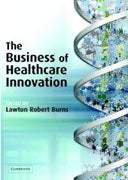When Lawton Robert Burns, Wharton professor of health care systems, began teaching healthcare management to graduate students, he found a hole in the academic literature. There was plenty of material on physicians and hospitals, government regulations and insurance issues. But there was no single source of good information on a key component of the healthcare industry — the producers of healthcare products.
Burns aims to fill that gap with his new book, The Business of Healthcare Innovation. The book focuses on four sectors — pharmaceuticals, biotechnology, medical devices and information technology — and explores the challenges that each faces in bringing new products to the market.
The book was edited by Burns and includes contributions from him and other Wharton School faculty, as well as industry leaders. Its goal is to look at the internal and external factors at work in determining whether a new pill or new pacemaker ends up in the hands of patients and doctors.
Each of the sectors is involved in providing goods and services aimed at improving patients’ health and even saving lives, but these products come with ever-increasing price tags. While focusing on the business of healthcare innovation, Burns’ book can’t help but raise a critical question: Will the health system continue to be able to pay for it all?
Burns says he hopes his book will be useful in both the classroom and the real world. Students in health administration need to be knowledgeable about the producer side of the healthcare equation, he notes, not just because of the growing reliance on medical technology but also because of the expense. “The fastest growing portion of hospital costs are these supplies,” whether drugs or medical-surgical supplies, and hospital administrators should be savvy about the companies they deal with. “They need to take an active role. Hospitals need to understand what makes the companies tick.”
At the same time, Burns adds, the different sectors, whether biotech or medical devices, must understand how each other operates, especially given a trend toward “convergence” of technology. “One of the reasons we wrote this book is that there is a slow but growing convergence of these products. One sector will increasingly rely on another sector for new product development.” New drug-coated stents, which are part medical device and part pharmaceutical, are a good example.
Burns, who is director of the Wharton Center for Health Management and Economics, sets the context for the book by noting that the health products industry is both huge and profitable. Nine drug companies and four medical device firms are among the Fortune 500, based on 2003 revenues. That same year, pharmaceutical, biotech and medical devices firms generated over $600 billion in revenues worldwide.
He devotes considerable space in the book to pharmaceuticals, leaving it to industry veteran Jon Northrup to explore the complexities of the drug business, which saw U.S. sales grow from $14 billion in 1980 to $220 billion in 2003.
The drug industry is frequently criticized by patients, consumer groups and others for charging too high prices and making too much money. Investors complain of companies lacking in innovation. But Northrup presents a mostly sympathetic view of the industry, which he says involves “the interplay of high risk, long time lines for development and the investment returns required to motivate stakeholders to engage in the business model.”
The risk is high, he suggests, because R&D is marked by many more “dry wells” than “wet wells.” It takes about 100 research products for a company to end up with two or three drugs on the market. The R&D timeline also is daunting: Moving from bench to bedside can require more than a dozen years.
“So, looking forward at 12 years to market and 2% probability that the project makes it to market, one has a very challenging business model to fund competitively,” Northrup writes. Given that, the blockbuster mentality of pharmaceutical R&D is understandable. “It takes a blockbuster (a product that sells $1 billion or more a year) to make money,” he writes. Still, the majority of new drugs are only “base hits.”
Northrup says the industry must make drug development more cost-effective. “Ways need to be found to pull the risk forward and fail fast in development,” allowing questionable projects to die quickly. Drug companies already are turning to various business arrangements, from in-licensing deals with biotech firms to outright acquisitions, to get a better flow of products from the pipeline.
Believing Their Own Press Releases
Many of the challenges facing the drug industry are magnified in the biotech field. Without long track records to point to, a company’s success is highly dependent on convincing investors that it’s on to something new, interesting and marketable.
Cary G. Pfeffer, an advisor to the biotech industry, writes that the still-young field can be viewed either as a disappointment or a success. He cites a Wall Street Journal article reporting that the industry has accumulated $40 billion in losses. On the other hand, there are more than 196 biotechnology drugs on the market, “many of which have had a substantial impact on patients’ lives worldwide.”
Pfeffer says the success of biotech companies depends on many things, including the presence of top-notch managers and the ability to be objective. While biotech has the image of being creative and flexible, Pfeffer says that “too often, biotechnology companies begin to believe their own press releases, and fail to stop or change the course of programs soon enough.”
He, too, foresees more coming together of big pharma and biotech. “Growing numbers of big pharmaceutical companies are depending on biotechnology for new products, new technologies, and scientific innovation,” he writes.
Biotech also is poised to reap the benefits of new technologies, including gene therapy and products from the new fields of genomics and proteomics. But that will take time. “While there was some economic reward for the creation and use of tools, the anticipated cash streams from the sale of drugs based on genomic/proteomics discoveries will take a decade or two longer than expected,” Stephen M. Sammut, a Wharton senior fellow and venture capital partner, writes in another chapter that looks at biotechnology.
The chapter on medical devices is especially upbeat. Author Kurt Kruger, who followed the industry for Wall Street, says this sector is “by any measure one of the most attractive and profitable in all of American commerce.” The average operating profit margin for six of the larger device companies was 26% in 2003.
He suggests that a principle of economics — that as the price of goods rises, demand falls — does not seem to hold true for medical devices. “In medical products, growth is sustainable because it is driven by demographic trends, the continued prevalence of diseases, and the fact that there is a near infinite capacity for absorbing medical technology within the practice of medicine,” he writes.
Kruger offers the example of implantable defibrillators, which monitor the heartbeat and give a potentially life-saving shock when needed. About 125,000 of the devices, at approximately $25,000 each, were implanted in the U.S. in 2003. Stents are another example. About 1.2 million bare-metal stents were implanted in the U.S. in 2002. Then along came drug-coated stents, designed to prevent the reclogging of arteries. They go for about $3,000 each — triple the cost of plain stents — but no one seems to be balking.
The business model is different for medical device companies because the customer is not the patient, but rather a defined group of physicians who select the products, Kruger says. About 1.5 million stents are placed annually, yet only 14,000 interventional cardiologists do the brand selection. Hip implants are installed in hundreds of thousands of patients in the U.S. annually, yet only 17,000 orthopedic surgeons do the procedures. Device companies are able to aim their marketing efforts directly at doctors, avoiding the expense of convincing patients that one pacemaker is better than another.
Looking ahead, Kruger says the trend toward integrated drug-device products, such as coated stents, is bound to increase. A combo device being used in back surgery involves a metal spine cage prepacked with a drug to promote bone growth.
The last health product sector looked at in Burns’ book is information technology, whose promoters envision a future where patient records are completely electronic and accessible from anywhere; where physicians and nurses enter orders in a computer, not on a chart, with the goal of improving care and reducing errors; and where patients in intensive-care units and other wards can be monitored by specialists from afar.
Despite such promise, the chapter’s author, Jeff C. Goldsmith, says the pace at which the healthcare industry has embraced IT is “glacial,” lagging behind that of other industries. The reasons are many. Health organizations are complex and IT systems are not one-size-fits all. There’s also a human factor that can impede progress: Hospital personnel — doctors, nurses, pharmacists — may resist change, preferring to do things the way they always have. “I think the promise of IT is overblown in the short term but underestimated in the long term,” Burns says.
In the end, his book will allow both students and healthcare professionals to assess how an array of products will affect patient care today and tomorrow. The health products market is one to watch.


